| Reports of visits to Japan of POWs |
2014 Former Australian POWs visit Japan at the fifth invitation of the Japanese Government
2014-10-20/27
Four former POWs and their family members visited Japan from October 20 to 27, 2014. This is the fifth program that the Japanese government has run for former Australian POWs. All of them were over 90 years old and the oldest was 97 years old. They were warmheartedly welcomed everywhere they visited and enjoyed the fruitful trip.
Description of the participants
|
Mr. Lewis Lawrence Cedric Hill (91) |
|
|
Born in 1923, lives in Victoria. Captured in Singapore at the surrender on 15th February 1942 and interned at Selarang Barracks. He worked as a POW to identify dead soldiers through their dog tags, construct roads and erect a Japanese shrine. On the 29th November 1942, he was sent to Japan by the Kamakura Maru. From Nagasaki on a one-day train trip, he arrived at Naoetsu on the 8th December 1942. His job there was mainly to shovel iron ore, coal, salt and stones. As a punishment, beating and standing in the snow were quite regular. Food was scarce and he was suffered from Beri Beri, Dengi Fever, Chronic Diarrhea, Septic Sores, etc. At home, nobody knew whether he was alive or dead, when his parents heard a broadcast from the ABC in July 1943 reporting the list of POWs in Japan, his name was on it. He was released on the 5th September 1945. He worked for 37 years as a primary school teacher and a principal. He wishes to have friendly discussions with Japanese people for a better understanding. |
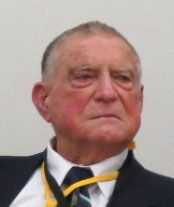
|
|
Mr. Milton (Snow) Fairclough (93) |
|
|
Born in 1920, lives in Western Australia. Captured on Java on the 9th March 1942. From Java to Singapore on the "Usu Maru", he was then sent to the Railway as a member of Weary Dunlop's 1000. He was in some camps, but the Hintok Jungle Camp was horrible. The Japanese soldiers were really sadistic and he used to have been bashed with bamboo, wooden clogs and rifle butts. Face slapping was quite common. Having been suffered from malaria, chronic amoebic dysentery, beri beri and happy feet, his weight went down to 38 Kg. Once when he was on a bamboo bed with chronic amoebic dysentery, a guard came and yelled, "You fit". He proceeded to bash him with the rifle butt off the bed. Dr. Dunlop appeared and firmly rejected to let the patient go for work. More screaming and yelling from this guard, but he was discharged. Released on the 28th August 1945., on his birthday at Bangkok. He enjoys driving a car and visits Thailand annually on ANZAC DAY (Nine times so far), 25th April. After seeing the result of the tsunami in Japan on the TV, his feeling changed and his sympathy for the whole Japanese Nation encouraged him to come to Japan. |
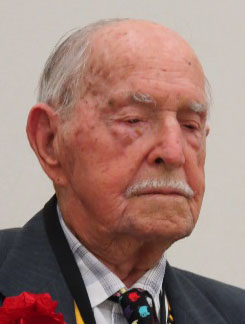
|
|
Mr. Richard Ridgwell (96) |
|
|
Born in 1918, lives in Western Australia. At the age of 20, he began mining, when WW2 broke out. With his friends, he voluntarily enlisted in the army. It seemed to have an opportunity for adventure, a chance to travel the world while defending his country. He was taken prisoner in Singapore. After having been interned in Changi Jail, he was sent to the Railway as one of 60,000 POWs and 180,000 Asian civilian labourers. British engineers had a previous survey of the route and concluded the building of a railway there was unachievable. During his three and a half years, he was at many sites and at Hellfire Pass, too. Many men died while cutting this infamous pass. After the war, he married his sweetheart who had waited faithfully for him, no matter if he was alive or dead. He has 2 sons, 4 grandchildren and 5 great grandchildren. He still lives independently in the family home and enjoys driving a car. |
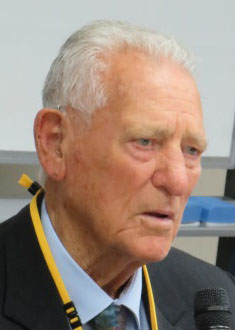
|
|
Mr Russell Ewin (97) |
|
|
Went to Wake Island as a laborer in 1940 and was captured there in December 23, 1941 |
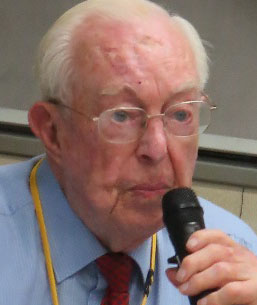
|
Itinerary
| 20 Oct. (Mon) | Arriving at Narita |
| 21 Oct. (Tue) | Meeting with members of the Diet, Visiting the Australian Embassy |
| 22 Oct. (Wed) | Courtesy visit to the Minister of Foreign Affairs, session with citizens |
| 23 Oct. (Thu) | Visit to the Commonwealth War Cemetery, Yokohama |
| 24 Oct. (Fri) | Visit to Hiroshima or Joetsu |
| 25 Oct. (Sat) | To Kyoto |
| 26 Oct. (Sun) | Visit to Ryozen-Kannon Temple and some spots in Kyoto |
| 27 Oct. (Mon) | Departing for Australia |
Meeting with the Diet members and former Korean guard
On the afternoon of 21 October, former POWs had a meeting with the Diet members at their office. This meeting was proposed by Mr. Yukihisa Fujita. He had been expending his efforts to solve the POW issues for many years. Each former POW talked about his bitter experience in wartime. During the meeting, although they became not aware of, Mr. E-Hanne, a Korean was sitting on the other side of the table. He was a guard at Hintok Camp during the notorious Thai-Burma Railway construction. Mr. Fairclough, one of former POWs, stayed at Hintok Camp and worked on the Railway. In his memoirs, he wrote about a Korean guard nicknamed "Lizard." He used to inflict violence on the POWs. Mr. E-Hanne was the very man - the "Lizard."
After their talk was over, Mr. Fujita introduced Mr. E-Hanne to former POWs. Mr. E-Hanne read the following message. "I was a Korean guard at Hintok Camp during the war. POWs were placed under extremely severe conditions there, and made to work with meager food and lack of medical supplies. In consequence, many of them died. As being a member of the former Imperial Army, I sincerely apologize you for the cruel treatments carried out on you. After the war, on accusation from 9 Australians, I was sentenced to death. Later on, sentence was commuted to 20 years, and I was transferred to Sugamo Prison in Tokyo.
I was released from Sugamo in 1956, and have been living in Japan for 60 years since then. However, we, former Korean war criminals, have never received any support nor compensation from the Japanese Government as the former Japanese war criminals have. We believe it so unreasonable, because we had been employed as members of the Imperial Army, and tried as such. We have had difficult times in Japan as foreigners. We have made petitions to the Japanese Government to solve this unreasonable treatment, but it has not yet been solved."
Hearing his message, Mr. Fairclough was flabbergasted. His son hurriedly came up to the table POW RNWJ members were sitting, and asked what Mr. E-Hanne's name was. Mrs. Sasamoto told him his nickname was "Lizard." Then they wore an expression of mixed feelings on their faces. After the meeting, Mr. Ridgwell, who worked at the most dangerous construction spot called "Hellfire Pass," came to shake hands with Mr. E-Hanne, but Mr. Fairclough was so amazed and at a loss that he did not shake hands with Mr. E-Hanne.
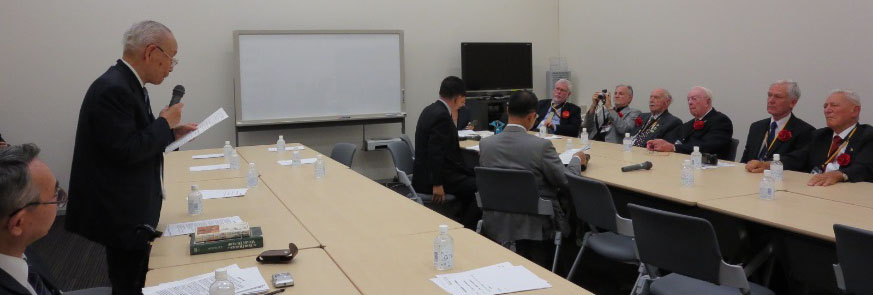 |
| Mr. E-Hanne (left) apologized the former POWs (right) |
Meeting with Japanese Citizens
On the afternoon of 22 October, a friendship meeting between former POWs and Japanese citizens was held down town Tokyo. The meeting turned out very fruitful with some 60 participants, including former POWs and their families. Please See for details. >> Link to PDF
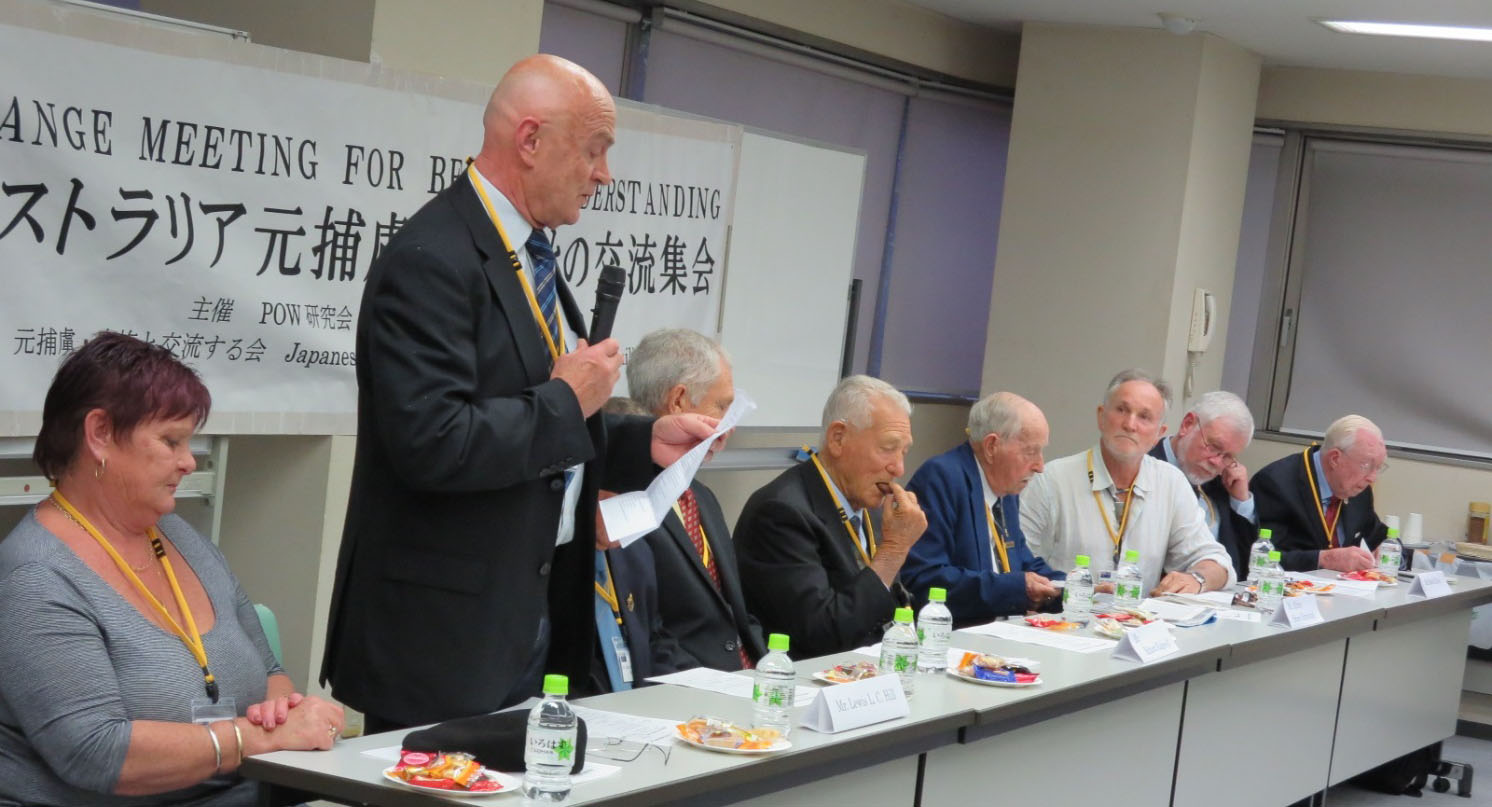 |
| Former POWs and their families at the meeting |
Mr. Braithwaite's talk: My father survived ‘Sandakan Death March'
After the friendship meeting, interested POWRNJ members listened to an account talked about by Mr. Braithwaite, accompanying Mr. Ewin. Mr. Dick Braithwaite, his father, was one of the 6 survivors of the Sandakan Death March. Please See for details. >> Link to PDF
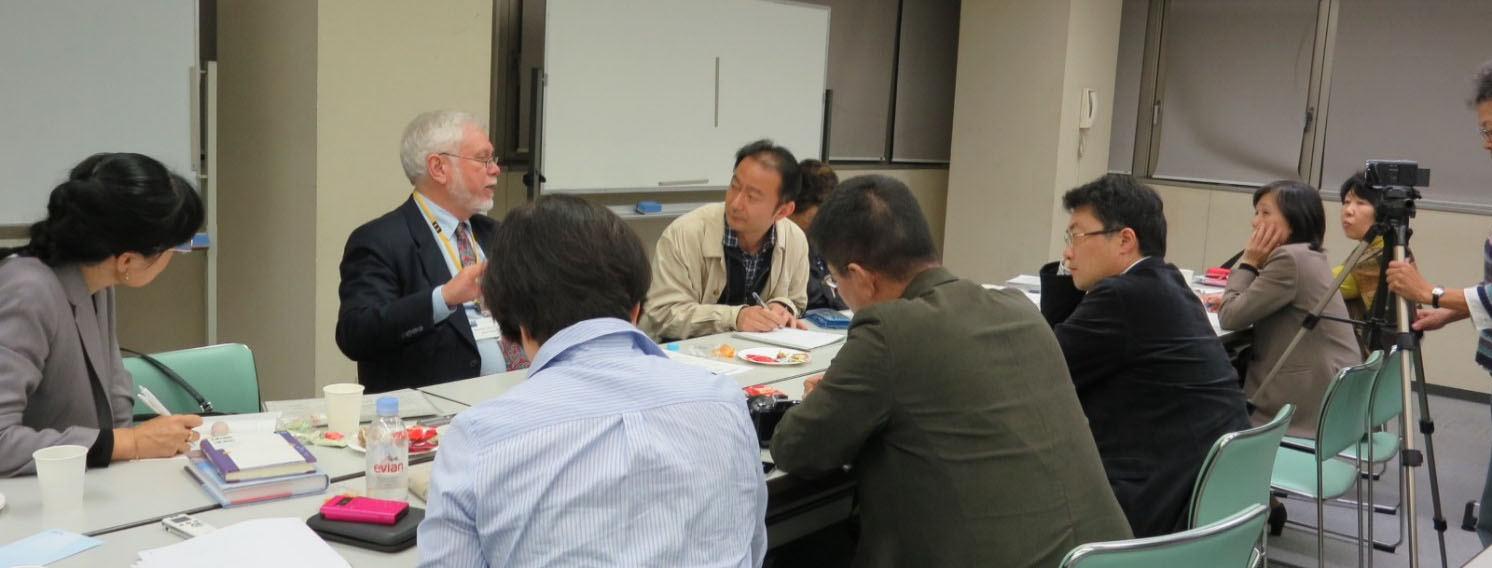 |
| Mr. Braithwaite (Second from left) talked about his father's experience |
The Commonwealth War Cemetery in Yokohama
On 23 October, former POWs and their families (less Mr. Ridgwell and his son) visited the Commonwealth War Cemetery in Yokohama. Unfortunately, it was raining, but many people visited the Cemetory, and the Australian Embassy held a solemn memorial service, and they reverently placed flowers on the graves of their comrades.
Thereafter, 31 pupils from nearby Setogawa Primary School came to see them. The children sang lovely songs to the POWs, and asked them about their experiences in their captivities, and the life in Australia. Both enjoyed the meeting very much.
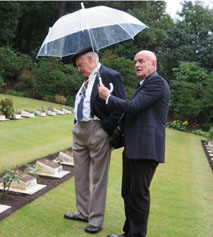 |
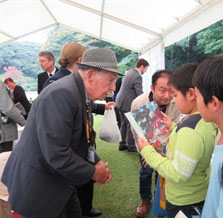 |
| Mr. Hill seeing his comrade's grave | Mr. Fairclough and children |
Mr. Hill visited Naoetsu
On 24 and 25 October, Mr. Hill, with his son and daughter, visited Naoetsu for the third time. He had stayed there for 2 years and 9 months during the war as POW. They were welcomed friendly by the members of the Japan and Australia Society of Joetsu. They visited the Peace Memorial Park landscaped the old POW Camp site by the local people in 1995. At Naoetsu POW Camp, 60 Australians perished in captivities thru hardships, and 8 Japanese were executed as war criminals after the war. The local people erected 2 memorial monuments in the Park to console the souls of those deceased people of both sides. However, none of former POW visited this Park has ever come close to the monument for the Japanese. During his visit, however, Mr. Hill offered flowers to the monument for the Japanese for the very first time. This made a great impression on all attendees.
On the following day. Mr. Hill and his family visited Nihon Stainless (present Shin-Nittetsu Sumijuu-Kin) Naoetsu factory he once had worked, and Kakushin-ji Temple, the ashes of those deceased POWs had been kept. Although other temples declined to keep the enemy soldiers' ashes, Rev. Enji Fujito, then the priest of this temple said, "Amongst the dead, there are neither friend nor foe," and shared food with the POWs brought the ashes to the temple.
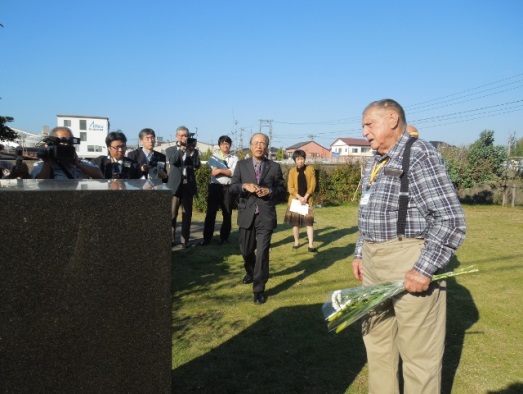 |
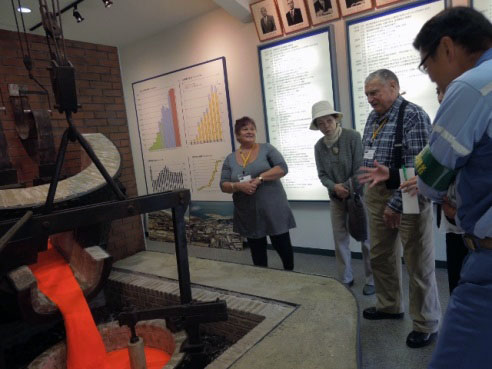 |
| Mr. Hill offered flowers to the monument for the Japanese | At the museum of the factory |
Messrs. Ewin and Fairclough visited Hiroshima
On 24 and 25 October, Mr. Ewin, his friend Mr. Braithwaite, Mr. Fairclough and his son, four of them visited Hiroshima. At Nobori-cho Primary School, they enjoyed meeting and talking with the children, and listening to their lovely songs. Then Mr. Shigeaki Mori (he unearthed the untold story on those Americans) guided them to see the memorial plate bearing names of the 12 US aviators placed on the wall of a building standing at the old site of the Chugoku Kempeitai Hqs. they were detained near the ground zero.
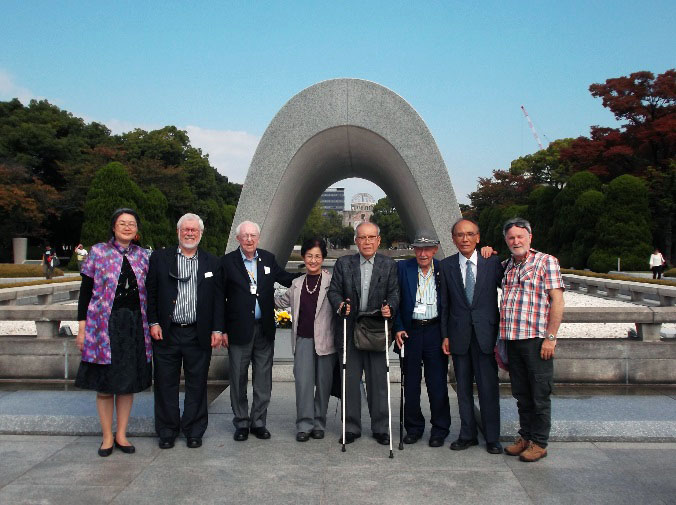 |
| At Peace Memorial Park, Hiroshima |
Visit to Ryozen Kannon Temple in Kyoto
On 26 October, all the people but Mr. Ridgwell and his son, assembled in Kyoto to visit Ryozen Kannon Temple. In this temple, more than forty thousand cards for the Allied POWs and civilian internees deceased during WWII in Japan have been kept. Mr. David Moreton, a POWRNJ member, gave a briefing on the cards. Mr. Ewin was able to find his brother's card, which read, "12-9-44 Missing on board ship, Rakuyo Maru." He also found a card for Lieutenant Mathew, executed for his underground activities in Sandakan POW Camp.
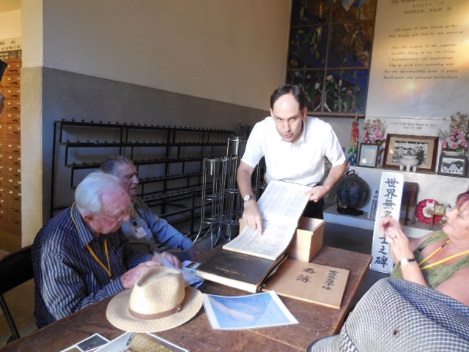 |
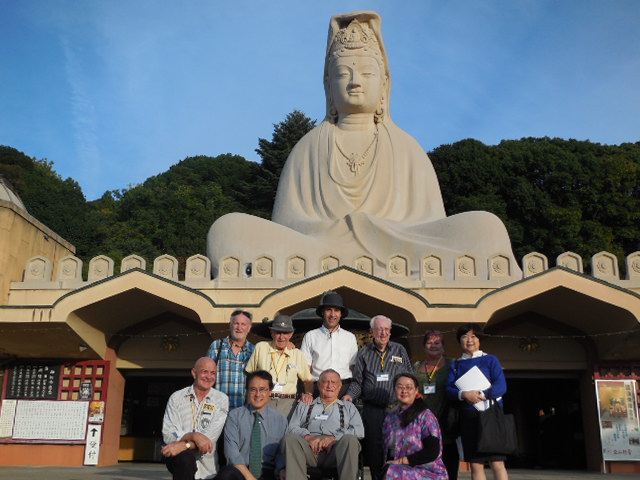 |
| At Ryozen Kannon Temple | Mr. Moreton explained about the cards |